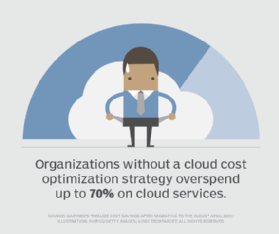
pixstock - Fotolia
Build cloud economics expertise in-house
Cloud bills shouldn't be filled with surprises, but unexpected costs are all too common. Ensure your staff can handle cost management and optimization processes to rein in spending.
Cloud economics is a complicated topic for any organization.
It's nearly impossible to ignore cloud cost optimization issues -- whether your organization is in the early discovery phase, currently migrating or already in the cloud. A knowledgeable staff across multiple departments can help reduce the sticker shock that comes with a high cloud bill.
Building cloud expertise in-house means promoting cross functionality. For example, IT staff must be aware of how their usage impacts the bottom line, while business leaders need to understand how the cloud works. Let's review several important concepts and tools related to cloud economics to get everyone in your enterprise on the same page.
Five tips to prepare staff to control cloud cost
1. Cloud training
Cloud training and certifications aren't just for the IT department. Education is key to building cloud economics and cost management expertise in-house, even with non-technical staff. No organization will understand the intricacies of cloud pricing without first cultivating general knowledge of cloud economics across the organization. It's time to consider sending some of your supply chain and accounting staff to certification training, such as CompTIA Cloud Essentials and the AWS Cloud Practitioner.
Traditional certifications might be out of reach due to budget restrictions or limits on employee availability, but there are online programs available, such as LinkedIn Learning, A Cloud Guru and Linux Academy.
2. Cost transparency
Organizations think the cloud is more expensive than an on-premises data center because they don't capture costs effectively throughout the entire process. That starts during the architecture and design phases, where expenditures often go unnoticed.
Put the tools in place to communicate -- at a high level -- all features and services that power your applications and environments. For example, it could take the form of a reference architecture that lays out all the services you have in production.
Enterprises are better positioned to spot potential money pits when there's cost transparency, and managers, IT staff and back-office staff understand their roles in keeping costs in check. As you put together plans for your cloud initiative, remember to factor in the costs of such training.
3. Storage costs
Organizations deploy a variety of cloud storage techniques, such as archival, reduced redundancy and backup -- each of which carries its own impacts on performance and cost. Architects need to communicate the cost implications of storage choices to the business side. A purchasing staff with foundational knowledge of cloud storage can ask the right questions about those choices and their impact on the business.

4. Cost calculators
Cloud cost calculators, such as the AWS Total Cost of Ownership Calculator, the Microsoft Azure Pricing Calculator and the Google Cloud Platform Pricing Calculator, help enterprises estimate monthly spend and make the right cloud economic decisions. Experienced users can breeze through these pricing tools, but non-technical staff should also be able to use these calculators for budgetary purposes.
These cloud cost calculators should become second nature to your whole team, which means it is critical to put together internal training to prepare staff.
5. Optimization tools
Proper management tools underpin cloud economic efforts because they help optimize your workloads and control costs. Cloud providers offer native options -- including Amazon CloudWatch and Azure Cost Management -- that can monitor usage and performance, as well as provide insights and recommendations.
There are also third-party cloud management platforms, such as CloudBolt and Cloudability, which can span environments, including your on-premises data center. Such tools can synchronize monitoring and cost management to get the more accurate picture of your cloud spending. Include staff involved in cloud economics in the use of these tools from the beginning so you can factor in their reporting and feature requirements.
Tie it all together with a framework or process
Depending on the size and charter of your organization, these concepts may span across teams and alter approaches to cloud migration, management and operations.
In either case, look for options to add a pricing action throughout your cloud lifecycle and processes. For example, have those involved in spending and budget decisions start work during the design and discovery phase. Cross-team collaboration can help give a better view of future costs. Additionally, you should design reports and dashboards for your management and operations teams to monitor the financial health of the cloud.







